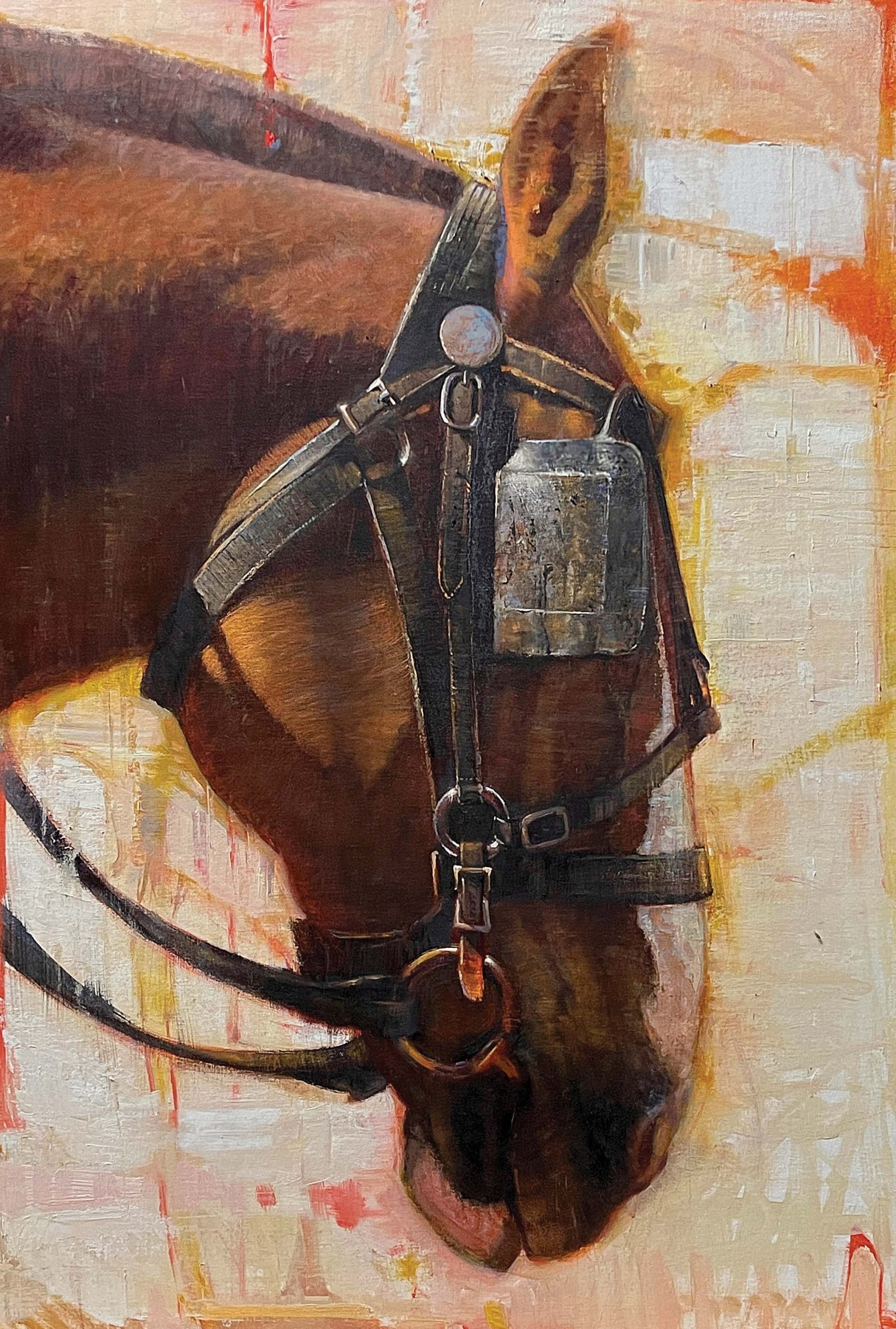
03 Jan A WILD STAND
Oil painter Elizabeth Pollie extracts the extraordinary from the ordinary. Her still-life depictions of shells and sake jugs, of tiny, blue-spotted eggs and feathers, reflect expansively on the alchemy of daily routine and pull on the threads of the lacy beginnings of awareness. She also takes in the cows in the field, the chickens in the yard, and the horse of her imagination. Her world consists of possibilities, inhabiting the secret cycles of the creatures she observes day after day.
“Whenever I paint something, there’s always the question of whether I can pull it off,” Pollie says. “It’s almost dizzyingly optimistic. But people need that optimism. A painting is a life with its own challenges.”
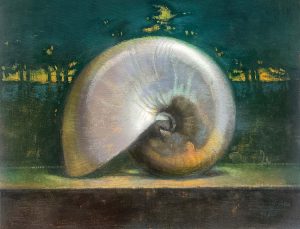
Practical Geometry | Oil on Canvas | 11 x 14 inches
In one such work, Practical Geometry, she places a nautilus shell shimmering with opalescence front and center. It sits on a ledge but feels like it’s floating Magritte-style, defying gravity. The background, dark and dusky, with an imaginary forest, allows room for meandering. The golden ratio of the nautilus brings with it a history deeper and longer than that of the dinosaurs and shows up in quite a few of her pieces.
“We can look to nature for the basic structures of the golden ratio, but the shells themselves are the most divine sort of architecture,” she says. “If you take a shell back to its first-minute structure, it’s a form of the true divine. It’s not that they’re very pretty; it’s just that they are these exquisite examples of natural architecture.”
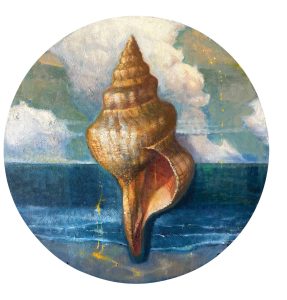
Aria 3 | Oil on Canvas | 12 x 12 inches
Painted on a circular canvas, one of Pollie’s pieces Aria 3 focuses on a winding shell with sculpted whorls like a swirling road around and around, narrowing to the top. The shell sits front and center; the water and heavy clouds are merely the background. And then, a splash of yellow, almost as if it escaped through the canvas like the remnants of a spell, reminds us that magic is present, always present.
“I take more risks with this type of work,” says Pollie, who owned a gallery representing her work and other artists’ from 2005 until 2022. “What I’ve found through having a gallery is that when you make work that goes beyond what reminds people of a trip they took or what looks like their own house, you give them permission to sense the world on a different level. A universal quality of mystery.”
Janet Lee, president of the non-profit American Women Artists, collects Pollie’s work. “We have a house on Lake Michigan, and when we bought the house, we started buying art for special occasions to furnish it,” Lee says. “We have 13 pieces, all sizes, all subjects. And now, they’re in both of our houses.”
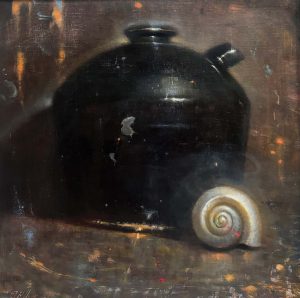
Shelf Life | Oil on Canvas | 16 x 16 inches
Lee notes how Pollie captures subjects with emotion and characters with brilliance. “The first painting we bought was a seagull nestled down on the beach. The use of color is so unique. I never get tired of looking at her pieces, and I learn something new each time I pass by one of her paintings.”
Lee appreciates how Pollie infuses her paintings with other-worldly light. “They are so moving,” she says. “There are abstract elements, but there’s a classically trained feeling to her work. There’s so much variety in what she does; [our] collection of her work is so interesting and varied that it doesn’t feel like a lot from a single artist.”
In some ways, Pollie’s work is the culmination of a life immersed in art. “I was that kid looking for a connecting point as to how I walked through life, through imagination, through spending time by myself, and creating,” Pollie says. “It was my safe space, and my whole world came out in artistic ways. It was inseparable from me. I think that what I’ve learned about myself is that art preserves a bit of that child who is still within me who is so happily engaged with the space between the real world and the private world.”
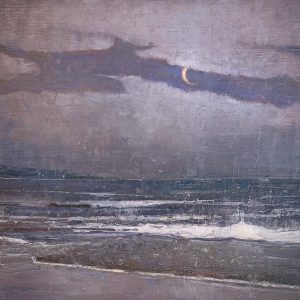
I’ll Be Seeing You | Oil on Canvas | 12 x 12 inches
Pollie always knew she would end up in art school. “I was really excited about all the art schools, and then my father told me what the budget was. I was so crestfallen,” she says. She attended the University of Michigan but didn’t love the art program, so she took a lot of theater classes. “I left the university and worked in the city hospital until I saved enough money to go to Florence for three months, where I could do printmaking.”
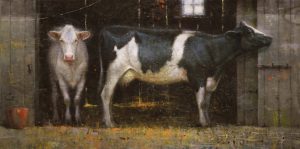
A Room of Their Own | Oil on Canvas | 20 x 40 inches
After a stint as an award-winning illustrator, she eventually returned to the College for Creative Studies in Detroit and ended up teaching as an adjunct. “I was ready to be the teacher because what I learned about art school is you go from class to class, and you don’t learn much,” she says. “I wanted to give the students more of a community they could learn from.”
Margaret Tvedten first met Pollie 25 years ago and represents her paintings at Tvedten Fine Art in Harbor Springs, Michigan. “First of all, the number one thing is the magic she creates in her work,” Tvedten says. “Not a lot of artists can do that. She is a perfectionist about the surface, but she always brings something special. Even when she paints a cow or a house, it has a certain magic. To me, there isn’t another artist I represent that can create something that makes you want to stare at it like that. Some painters give you a memory of a landscape, but with Elizabeth, she tells a story.”
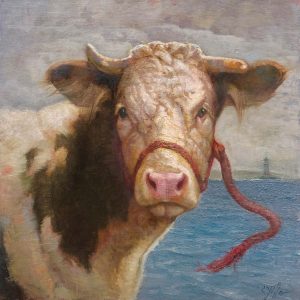
The End of Her Rope | Oil on Canvas | 18 x 18 inches
In the painting The End of Her Rope, Pollie conveys a deeply personal look at a cow whose rope is untethered and frayed. The eyes catch the viewer and do not let go.
“It alludes to these moments, not only the life of animals but the moments of humans that are monumental and courageous moments,” Pollie says.
Inspired by nature’s creatures big and small, Pollie feels it is enriching to interact with them. “I love animals. As a kid, I brought home snails, snakes, anything that needed help.”
This rescue effort continues today. “I picked up a seagull on the beach that had a fishing lure on his beak,” she says. “I had it in my bathtub for a while.” Eventually, she got the lure out and brought the seagull back to the beach. “We don’t share a common language, but we do share a common space. So, when I paint an animal, I paint it with that sense of deep admiration and love that has been a touchpoint in my entire life.”
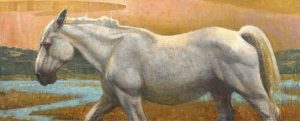
Lost Horse Lake | Oil on Canvas | 16 x 39 inches
In Pollie’s painting Lost Horse Lake, she wanted to paint the idea of freedom. “I wanted the feeling of this horse completely untethered and far from the human world,” Pollie says. “The horse was actually one I passed by every day until it was gone.” However, the idea of this horse and what it symbolized to her did not go away but lived in her mind for a long time before she began painting it.
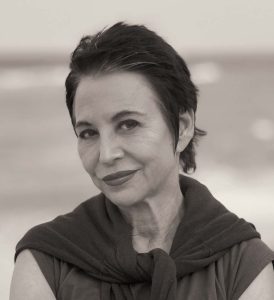
Artist Elizabeth Pollie
“It’s about the point in life when you take this wild stand,” she says. “When you know that moment has come for you to find the real life you were intended for.”






No Comments